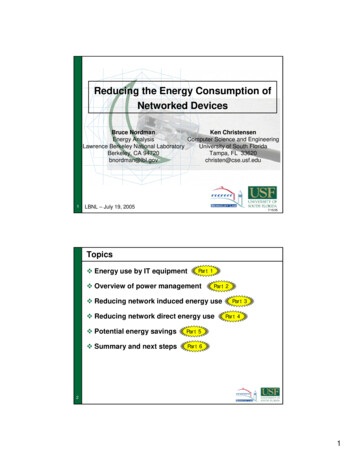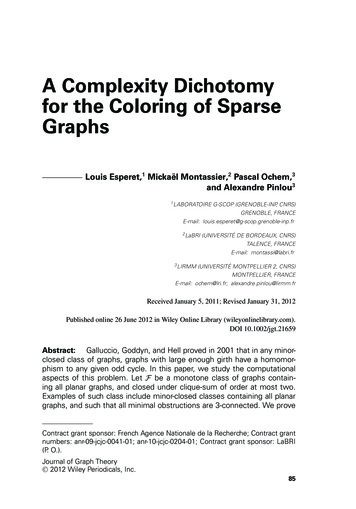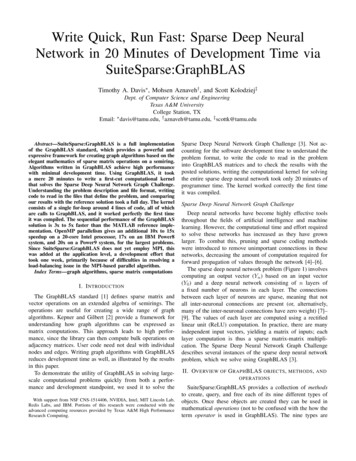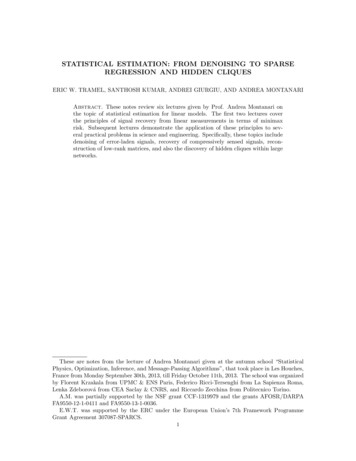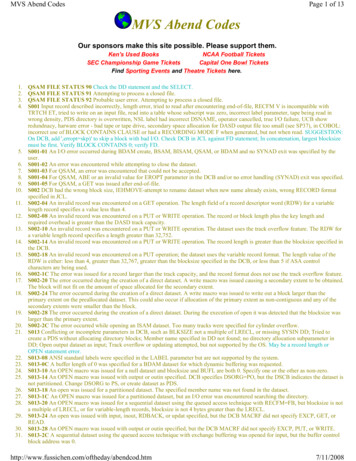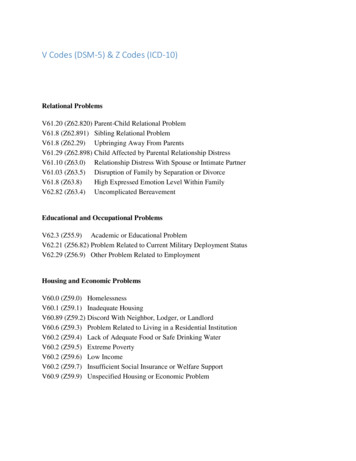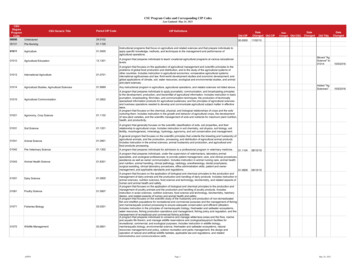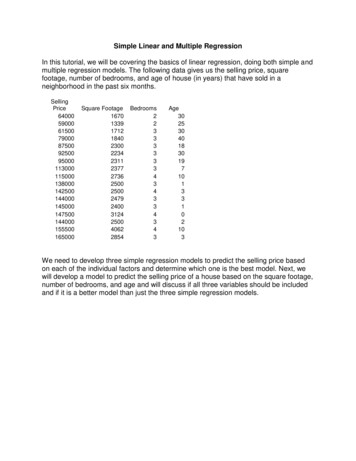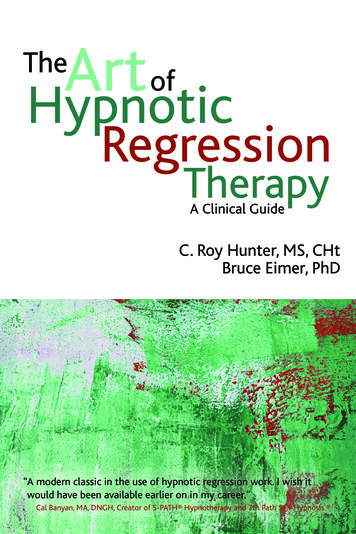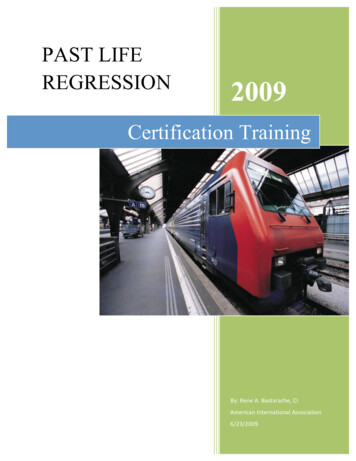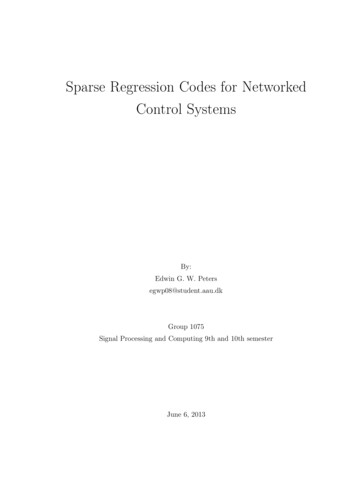
Transcription
Sparse Regression Codes for NetworkedControl SystemsBy:Edwin G. W. Petersegwp08@student.aau.dkGroup 1075Signal Processing and Computing 9th and 10th semesterJune 6, 2013
Department ofElectronic SystemsFredrik Bajers Vej 7DK-9220 Aalborg ØstPhone: 45 96 35 86 00Internet: es.aau.dkAbstract:We study a Networked Control System (NCS) architecturefor Linear Time Invariant (LTI) plants, where an unreliabledata rate limited network, with random Independent andIdentically Distributed (IID) packet dropouts occurring,connects the plant and the controller.To achieverobustness of the control system with respect to IIDTitle:dropouts, a receding horizon controller is used whichSparse Regression Codes forminimizes a finite horizon cost function. To deal with rateNetworked Control Systemslimited networks, we, in this thesis, wish to design sparseTheme:packets using l0 penalized optimization. This is done onMaster’s thesisSparse Regression Code (SPARC) dictionaries containinglattices or IID Gaussian samples.Project period:We transmit the current and expected future controlSeptember 2012 - June 2013signals, such that on reception of the packet, the currentProject group:signal as well as the next N 1 future control signals can13gr1075be reconstructed in the plant. The distinguishing factorsMembers of the group:of this thesis regarding to other available studies is thatwe use a fixed rate vector quantizer based on SPARC,Edwin G. W. Petersfeaturing a finite support which can be overloaded in caseSupervisors:of heavy oscillations in the plant.Jan ØstergaardWe design different SPARC dictionaries and simulateDaniel E. Quevedothese in an NCS with different packet dropout rates on theNumber of copies: 4network. Results show good performance at bit rates downNumber of pages: 69to 2.75 bit/symbol with an IID packet dropout probability upto 0.20 when Gaussian IID SPARC dictionaries are used.Attachments: CDThe performance of a lattice SPARC dictionary is not ableAppendices: 2to reach these bit rates, and generally requires bit rates ofProject completed: June 6, 20133.75 or 4 bit/symbol to stabilize the NCS.Finally we state an alternative network model featuringtwo network states with different dropout probabilities. Adifferent SPARC dictionary is designed for each networkstate. We stated equations to analyze whether the systemwith given transition and dropout probabilities is stableusing Markov Jump Linear System (MJLS) theory. This isfollowed by simulations of NCSs featuring these networks.Contentsofthisreportisfreelyavailable,but publication (with specification of source) may only be done upon arrangement with the authors.
Institut forElektroniske SystemerFredrik Bajers Vej 79220 Aalborg ØstTelefon: 96 35 86 00Internet: es.aau.dkSynopsis:I denne afhandling undersøges Netværksbaserede Control Systemers (NCS) architecturer for Lineare Tidsinvariante (LTI) systemer, hvor et upålideligt båndbredde begrænset netværk med random IID pakketab, forbinder systemet (plant) og controlleren. For at gøre kontrolsystemetTitel:Sparse Regression Koder forrobust m.h.t.Netværkedsbaseredezon controller som minimerer en finite horizon cost funktion.KontrolsystemerIID pakketab, bruges en aftagende hori-For at kunne håndtere båndbredde begrænsedenetværk, designes der i denne specialeafhandling sparseTema:contol pakker ved brug af l0 penaliserede optimeringsKandidatspecialealgoritmer på SPARC baserede ordbøger indeholdendeIID Gaussiske vektorer eller latticer. Der sendes expect-Projektperiode:ede fremtidige samt et nutidigt control signal til planten,September 2012 - juni 2013således at N 1 fremtidige controlsignaler kan genskabesProjektgruppe:såfremt pakken modtages af planten. De faktorer der ad-13gr1075skiller denne specialeafhandling fra andre bidrag er, at derMedlemmer af gruppen:bruges fixed rate vektor quantizere baseret på SPARC, derEdwin G. W. Petershar et finitivt support og derved kan overloade quantizereni tilfælde af at der sker oscillationer i planten.Vejleder:Der designes forskellige SPARC ordbøger, der simuleresJan Østergaardi et NCS med forskellige pakketabsrater på netværket.Daniel E. QuevedoResultaterne viser en god ydelse for bitrater ned til 2.75bit/symbol når sandsynligheden for IID pakketab ikkeAntal kopier: 5overstiger 0.20. Dette ved brug af Gaussiske IID SPARCAntal sider: 69ordbøger. Lattice SPARC ordbøger opnår derimod ikkeBilag: CDden samme ydelse ved disse bitrater, og kræver genereltAppendikser: 2bit rater på 3.75 eller 4 bit/symbol for at stabilisere et NCS.Projekt afsluttet: 6. juni, 2013Til sidst opstilles der en netværksmodel indeholdendeto states med hver deres pakketabsrate. Der designesforskellige SPARC ordbøger for hver state netværket kanantage.Der opstilles ligninger baseret på MJLS teori,således stabilitet for et system med givne transitions- ogpakketabs sandsynligheder kan analyseres. Til sidst ersystemer baseret på disse netværk blevet simuleret.Rapportens indhold er frit tilgængeligt, men offentliggørelse (med kildeangivelse)måkunskeefteraftalemedforfatterne.
PrefaceThis thesis is composed during the 9th and 10th semester during the Autumn of 2012 andthe Spring of 2013. It is written by a student studying “Signal Processing and Computing”at Aalborg University in Denmark in cooperation with the University of Newcastle inAustralia.The target audience for this thesis are students, researchers and others with abackground in vector quantization and signal compressing, optimization, NCSs designand others interested in these topics.The citations in this thesis are referred by a number in square brackets, e.g. [1],with details to be found in the bibliography located on page 69. The abbreviations usedin this thesis are explained in the Abbreviation list on page ix. All matrices are denotedwith a bold capital letter, i.e. M where M T denotes its transpose. Vectors are denotedwith a bold lower case letter i.e. v, and scalars in normal lower case i.e. u. I denotes theidentity matrix, containing 1’s on the diagonal. diag {v} diagonalizes the vector v. We define kvkP v T P v for a positive definite matrix P and kvk2 v T v. The spectralradius of the matrix M is denoted by rσ (M ). The operator E {x} defines the statisticalexpectation of a random variable x, whereas var {x} denotes its variance.A CD is attached containing a digital version of this thesis and the scripts used forthe simulations performed herein.Finally, the author would like to thank Associate Professor Daniel Quevedo at theUniversity of Newcastle and Associate Professor Jan Østergaard at Aalborg University fortheir support and guidance during the writing of this thesis.v
Edwin G. W. Petersvi
Contents1Introduction1.1 State of the art . . . . . . . . . . . . . . . . . . . . . . . . . . . . .1.2 Problem description . . . . . . . . . . . . . . . . . . . . . . . . . .1122Rate-distortion theory2.1 Rate-distortion . . . . . . . . . . . . . . . . . . . . . . . . . . . . .2.2 Calculating the rate . . . . . . . . . . . . . . . . . . . . . . . . . . .5553Dictionary search73.1 Matching pursuit . . . . . . . . . . . . . . . . . . . . . . . . . . . . 73.2 Homotopy . . . . . . . . . . . . . . . . . . . . . . . . . . . . . . . . 103.3 Summary . . . . . . . . . . . . . . . . . . . . . . . . . . . . . . . . 184Control theory4.1 Control and feedback . .4.2 Controller design . . . .4.3 Model predictive control4.4 Summary . . . . . . . .21212325285Quantized PPC295.1 Packet Predictive Controller (PPC) with a quantizer . . . . . . . . 295.2 Closed loop PPC . . . . . . . . . . . . . . . . . . . . . . . . . . . . 305.3 Summary . . . . . . . . . . . . . . . . . . . . . . . . . . . . . . . . 316Dictionary design6.1 Gaussian dictionary . . . . . . . . . . . . . .6.2 Gaussian dictionary with scaled refinements6.3 Lattice dictionary . . . . . . . . . . . . . . .6.4 Dictionaries with variable scaling . . . . . .6.5 Summary . . . . . . . . . . . . . . . . . . .78Simulations7.1 Dictionary scaling - fixed gain . .7.2 Dictionary scaling - variable gain7.3 Dropout probabilities . . . . . . .7.4 Summary . . . . . . . . . . . . .Alternative dropout scenarios8.1 Scenario with two states . . . . . . . . . . . . . . .8.2 Dictionary considerations . . . . . . . . . . . . . .8.3 Stability of Markov Jump Linear Systems . . . . .8.4 Stability for MJLS with different dropout scenarios8.5 Verification . . . . . . . . . . . . . . . . . . . . . .8.6 Summary . . . . . . . . . . . . . . . . . . . . . . .333337384045.4747495154.55555656586062vii
CONTENTS9Conclusions6310Future research65Bibliography67Appendix73viiiALattice Gram matrices73BParameters for simulation75
AbbreviationsAWGNAdditive White Gaussian NoiseMSEMean Squared ErrorBIBOBounded Input Bounded OutputMPMatching PursuitBPBasis PursuitMJLSMarkov Jump Linear SystemECDQEntropy-Coded Dithered (lattice) QuantizerMSSMean Square StableIIDIndependent and Identically DistributedNCSNetworked Control SystemIPInteger ProgrammingOMPOrthogonal Matching PursuitLTILinear Time InvariantPPCPacket Predictive ControllerLQRLinear Quadratic RegulatorSNRSignal to Noise RatioMPCModel Predictive ControlSPARCSparse Regression Codeix
1 IntroductionLTI control systems are today used in many different places, occasions and situations.These systems all have in common, that there is a feedback from the system to becontrolled (plant) to the controller, maintaining the plant in a desired state. In some casesit might be desired to have the controller at another physical location than the plant, inwhich case a wired or wireless network connects these. This topology is called a NCS andcan have many advantages, such as lower cost, higher reliability and easier maintenance,but other challenges arise, including bit rate limitations, random delays and breakdowns,which leave the plant in open loop operation and can have severe consequences dependingon the situation.This chapter describes recent research in NCS and relevant topics. Afterwards theproblem considered in this thesis is described.1.1State of the artNCSs with random IID dropouts occurring and packet delays have been introduced andanalyzed in various studies [1, 2, 3, 4, 5, 6, 7, 8, 9]. General literature [10, 11, 12, 13]explains methods for Linear Quadratic Regulator (LQR) controller design and recedinghorizon controllers for linear plants as well as stability for those. The paper [6] showsstability results for cases where the maximum number of consecutive packet dropout isbounded, whereas [7] investigates NCS with bounded time-delays. [3, 4] analyzes meansquare- and stochastic stability of NCS based on a Markov dropout where an unboundednumber of consecutive packet dropouts can occur.Quantization within the NCS has been done in e.g. [4, 5, 8], where the controlleris forced to select the control vector from a finite constrained set of vectors using anearest neighbor vector quantizer, reducing the bandwidth required on the network, andanalyses the closed loop behavior of these. In [5] an Entropy-Coded Dithered (lattice)Quantizer (ECDQ) is used and closed loop stability is investigated using linear matrixinequalities based on MJLSs. Optimal rates for the entropy coder are calculated based onthe statistics of the NCS. MJLS stability using ECDQ is also investigated in [4], wherestochastic stability and bounds on the maximum packet dropout are investigated. Thework [2] relates the PPC to problems solved in compressed sensing, and investigates sparserepresentation of the control vector using Orthogonal Matching Pursuit (OMP) as well asproviding sufficient conditions for stability when the controller is used on a network withbounded packet dropouts.Source coding using SPARC in is introduced in [14] as codes to compress memorylessGaussian sources over AWGN channels and reaches rate-distortion results close to theoptimal rate-distortion function. In [15] a computationally efficient method is proposed for1
CHAPTER 1. INTRODUCTIONSPARCs, which achieves performance close to the optimal rate-distortion function whenused on IID Gaussian sources. The SPARC dictionary is constructed with the sectionsbeing interpreted as refinements of the previous sections using a scaling function. Thedictionary search in [15] is performed using an algorithm closely resembled to MatchingPursuit (MP). In [16] the homotopy continuation algorithm is described to performsearches on Gaussian IID Dictionaries, which traces all solutions for Basis Pursuit (BP)as a function on the regularization parameter. The homotopy continuation algorithm in[16] can additionally be used to select a regularization parameter based on the desiredsparsity of the representation of the signal.1.2Problem descriptionThe setup of the problem to be considered in this thesis is shown in Figure 1.1. Thecontroller and plant are connected through a network with random packet dropoutsoccurring, also called an NCS. The feedback path is throughout this thesis assumedto be stable with no packet dropouts ure 1.1. An illustration of the controller setup considered in this thesis.The next state of the plant is described with the following functionxk 1 Axk B1 uk B2 ωk , k N0 ,(1.1)with xk Rm describing the plant state at time k, A Rm m the system matrix of theplant, u R the control signal or input, B1 the input matrix and B2 ωn describing thenoise in the plant. Although uk can be an input vector, this thesis is limited to the scalarcase.Since there is a network connecting the controller and plant, there exists a probabilityfor signals (or packets) to be delayed or lost. This has to be taken into account, such thatthe plant is kept stable in case it does not receive the control data, which has beendescribed in e.g. [8, 10, 11, 12, 13], and other literature under the terms Receding HorizonControl and Model Predictive Control (MPC).Since we in this thesis focus on bandwidth limited networks, it is of high interest thatthe size of the control packets is reduced, which can be done using vector quantization.The papers [2, 4, 5] investigated this using different quantizers and methods. This thesiscontributes by applying SPARCs, presented in [14], on NCSs. The sparse regression codesare constructed as2
1.2. PROBLEM DESCRIPTION L columnsγ1,1··· γ1,N γ2,1 · · · γ2,NΓ . . . γM,1 · · · γM,Nhβ 0, · · · · · · · · · , 0, 1, 0L columns L columns γ1,N 1···γ1,2N···γ1,(L 1)N 1···γ1,LN γ2,N 1.···.γ2,2N.···γ2,(L 1)N 1.···.γ2,LN. γM,N 1···γM,2N···γM,(L 1)N 1···γM,LN1, 0, 0, · · · · · · · · · · · · , 0···0, 0 · · · · · · · · · · · · · · · · · · , 0, 1i(1.2), (1.3)with Γ RN M L , which is split up in M sections, each consisting of L code words, whichcan be used to generate a set W of linear combinations. The vector β being a M L 1vector, containing only one entry equaling 1 in every section m {1, 2, . . . , M }. Thesecan be used to estimate a signal x to compress(1.4)x̂ Γβ.We need to find the closest code word Γβ over all β B to x RN . Thus given a vectorx and some fixed code book Γ and β, we have to solve the minimization problemβ arg min kx Γβk2 .β B(1.5)The set B is non-convex which means, that (1.5) is a non-convex optimization problem,requiring methods that are able to solve these.In this thesis we will, based on the results in [4], present two methods to solvenon-convex dictionary searches, and modify these to operate on (1.5) to compare theperformance of these compared to traditional Gaussian dictionaries in Chapter 3. Chapter4 describes the basics on quadratic control and receding horizon control, followed by theincorporation of the quantizer in Chapter 5. Chapter 6 describes different dictionaries,that can be used in the NCS followed by simulations in Chapter 7. The remaining chaptersinvestigate different drop out scenarios in the network and stability criteria for these.3
2 Rate-distortion theoryWhen using a lossy source coding, we are interested in keeping the bit rate, measured inbit/symbol, as low as possible, while also maintaining a distortion on the signal. Thischapter briefly introduces the methods used to calculate the bit rate and distortion ofthe signals as well as the theoretic lower bounds on these. The measurement methodsintroduced in this chapter are used throughout the rest of the thesis.2.1Rate-distortionWhen signals are quantized, we wish to reduce the bit rate of this signal. This introducesan error, since parts of the signals are lost. Some error in the signal can be allowedin many occasions, including NCS. The error, calculated by the difference between theoriginal and quantized signal is called distortion, and can be calculated in different ways,such as Mean Squared Error (MSE) and Signal to Noise Ratio (SNR), which are used inthis thesis. The MSE is calculated as [17] DMSE E (x̃i xi )2 ,with E being the expectation operator. The SNR is given by [17] E (xi )2.DSNR DMSE(2.1)(2.2)The rate of a signal is often represented in the amount of bit needed to represent a signal,also denoted bit/symbol. In source coding it is often desired to minimize the bit rate for agiven distortion, also called rate-distortion. There exist a theoretical lower bound for therate that can be obtained for a given distortion, which for memoryless Gaussian sourcesis defined by [18]R(D) 1log22 σ2D ,(2.3)with R denoting the rate, D denoting the distortion, and σ 2 being the variance of thesignal. Practical source coders result in distortion levels higher that the rate-distortionlower bound, since the algorithms often are sub-optimal [17].Equation (2.3) can be rewritten to calculate the theoretical lower bound for thedistortion at a given rate byD(R) σ 2 2-2R .2.2(2.4)Calculating the rateIn this thesis the dictionary and vectors are constructed as5
CHAPTER 2. RATE-DISTORTION THEORYx̂ Γβ,(2.5)where Γ RN M L is the dictionary matrix containing M sections with L columns ofGaussian distributed samples with variance σ 2 . β is a M L 1 binary vector containingonly zeros and a single 1 in each section M . This results in the non-operational rateR Mlog2 (L)N(2.6)since the vector β is coded as M binary numbers indicating which index equals 1. Theoperational rate is calculated by ceiling (2.6) to the nearest integer value.6
3 Dictionary searchThis chapter describes two different algorithms to perform a dictionary search to estimate asignal x by a linear combination x̂ Γβ. These algorithms are described using Gaussiandictionaries, after which the algorithms are modified to perform a search on SPARCscontaining Gaussian entries.3.1Matching pursuitAs described in Equation (1.5) in Chapter 1, we need to solve the optimization problemβ arg min kx Γβk22 ,β β(3.1)and find sparse solutions to this optimization problem. This can be enforced by penalizingβ with the l0 -norm enforcing a limited number of non-zero entries in β, which results inthe reformulated optimization problemβ arg min kx Γβk22 kβk0 .β β(3.2)This can be done by e.g. performing an exhaustive search, comparing all combinationsof Γβ and picking the best solution. The complexity of an exhaustive search is O(LN ),where L is the dictionary size, and N the number of elements to use. This makes it verytime consuming to use an exhaustive search on larger dictionaries.An alternative to performing an exhaustive search is MP, which performs the innerproduct between columns of the dictionary Γ containing orthonormal rows, and x afterwhich it picks the solution containing the largest energy using the inner product. [19]β arg max hγi , xi γi(3.3)MP is a greedy algorithm finding the pro
The performance of a lattice SPARC dictionary is not able to reach these bit rates, and generally requires bit rates of 3:75 or 4 bit/symbol to stabilize the NCS. Finally we state an alternative network model featuring two network states with different dropout probabilities. A different SPARC
